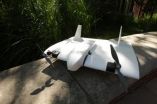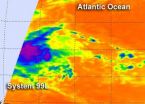(Press-News.org) A team of researchers has developed a cheap, rechargeable and eco-friendly battery that could be used to store energy at solar power plants for a rainy day.
Led by Sri Narayan, professor of chemistry at the USC Dornsife College of Letters, Arts and Sciences, the team developed an air-breathing battery that uses the chemical energy generated by the oxidation of iron plates that are exposed to the oxygen in the air – a process similar to rusting.
"Iron is cheap and air is free," Narayan said. "It's the future." Details about the battery will be published July 20 in the Journal of the Electrochemical Society.
As currently developed, Narayan's batteries have the capacity to store between eight and 24 hours' worth of energy. His patent is pending, and both the federal government and California utilities have expressed interest in the project.
Iron-air batteries have been around for decades – they saw a surge in interest during the 1970s energy crisis, but suffered from a crippling problem: a competing chemical reaction of hydrogen generation that takes place inside the battery (known as hydrolysis) sucked away about 50 percent of the battery's energy, making it too inefficient to be useful.
Narayan and his team managed to reduce the energy loss down to 4 percent – making iron-air batteries that are about 10 times more efficient than their predecessors. The team did it by adding very small amount of bismuth sulfide into the battery. Bismuth (which happens to be part of the active ingredient in Pepto-Bismol and helps give the pink remedy its name) shuts down the wasteful hydrogen generation.
Adding lead or mercury might also have worked to improve the battery's efficiency, but wouldn't have been as safe, Narayan said.
"A very small amount of bismuth sulfide doesn't compromise on the promise of an eco-friendly battery that we started with," he said.
Narayan's team included fellow USC researchers G. K. Surya Prakash, Aswin Manohar, Souradip Malkhandi, Bo Yang, Robert Aniszfeld, Chenguang Yang, Phong Trinh; and Andrew Kindler of NASA's Jet Propulsion Laboratory.
The California Renewable Energy Resources Act, signed into law by Gov. Jerry Brown in April 2011, mandates that the state's utilities must generate 33 percent of their power from renewable energy sources by the end of 2020.
This aggressive push toward renewable energy sources presents utilities with a problem: solar power works great on clear days and wind power is wonderful on windy days, but what can they do when it's cloudy and calm out? People still need electricity, and won't wait for the clouds to clear to turn the lights on.
Currently, solar and wind power make up a relatively small part of the energy used in California. In 2009, 11.6 percent of electricity in the state was generated by wind, solar, geothermal, biomass and small hydroelectric plants combined. (Large hydroelectric plants accounted for an additional 9.2 percent.) As such, dips in energy generation from solar and wind power plants can be covered by the more predictable coal-burning grid.
As California moves toward more renewable energy, solar- and wind-power plants will need an effective way of storing large amounts of energy for use during clouding and calm days.
Traditionally, utilities store power by pumping water uphill into reservoirs, which can then release the water downhill to spin electricity-generating turbines as needed. This method is not always practical or even feasible in drought-ridden California, where water resources are already in high demand and open reservoirs can suffer significant losses due to evaporation, Narayan said.
Batteries have typically not been a viable solution for utilities. Regular sealed batteries, like the AAs in your TV remote, are not rechargeable. Lithium-ion batteries used in cell phones and laptops, which are rechargeable, are at least 10 times as expensive as iron-air batteries.
Despite his success, Narayan's work is still ongoing. His team is working to make the battery store more energy with less material.
INFORMATION: Funding for this research came from the Advanced Research Projects Agency for Energy (ARPA-E), an arm of the U. S. Department of Energy.
New York, NY and Oxford, UK, August 1, 2012 – The body has a built-in system known as autophagy, or 'self-eating,' that controls how cells live or die. Deregulation of autophagy is linked to the development of human diseases, including neural degeneration and cancer.
In a study published online this week in the Proceedings of the National Academy of Sciences, scientists at the Ludwig Institute for Cancer Research in Oxford discovered a critical molecular switch that regulates autophagy. They also studied the links between autophagy and a cellular process called senescence ...
Archaeological sites that currently take years to map will be completed in minutes if tests underway in Peru of a new system being developed at Vanderbilt University go well.
The Aurora Flight Sciences unmanned aerial vehicle will be integrated into a larger system that combines the flying device that can fit into a backpack with a software system that can discern an optimal flight pattern and transform the resulting data into three-dimensional maps. The project is an interdisciplinary collaboration between Vanderbilt archaeologist Steven Wernke and engineering professor ...
A pilot study in adolescents and adults has found that an investigational drug shows promise as the first potential medical treatment for children with the severest type of congenital hyperinsulinism, a rare but potentially devastating disease in which gene mutations cause insulin levels to become dangerously high.
"There is currently no effective medicine for children with the most common and most severe form of hyperinsulinism," said study leader Diva D. De Leon, M.D., a pediatric endocrinologist at The Children's Hospital of Philadelphia. "Our new research shows that ...
NASA's Aqua satellite spotted some very cold, high, thunderstorms around the center of a tropical low pressure area in the Atlantic Ocean today, indicating that the system is getting stronger and more organized.
The low pressure area, designated as "System 99L" was located about 850 miles east of the southern Windward Islands, near 10.7 North latitude and 46.9 West longitude. It was moving west between 15 and 20 mph.
NASA's Aqua satellite passed over System 99L on August 1 at 0405 UTC (12:05 a.m. EDT) and the Atmospheric Infrared Sounder (AIRS) instrument captured an ...
Montreal, August 1, 2012 – Caffeine, which is widely consumed around the world in coffee, tea and soft drinks, may help control movement in people suffering from Parkinson's. This is the finding of a study conducted at the Research Institute of the McGill University Health Centre (RI MUHC) that was recently published in Neurology®, the official journal of the American Academy of Neurology. The study opens the door to new treatment options for Parkinson's disease that affects approximately 100 000 Canadians.
"This is one of the first studies to show the benefits of caffeine ...
Scientists at the Smithsonian and their colleagues have discovered a new mechanism of animal mating plug production. In the giant wood spider Nephila pilipes, a highly sexually dimorphic and polygamous species, many small males compete with one other for access to a few huge females. During copulation these males are known to sever their own genitals in an attempt to plug the female, thereby gaining paternity advantage by preventing other males from mating with her.
Until recently however, nothing has been known about the origin and function of additional and very solid ...
NASA's Terra satellite captured two tropical cyclones on visible imagery today, August 1 as they head for landfall. Typhoon Saola is approaching Taiwan and Typhoon Damrey approaching southern Japan, are both headed for landfall in China. Saola is forecast to landfall south of Shanghai on August 3, while Damrey is forecast to make landfall north of Shanghai on August 2.
NASA satellites have been tracking the twin tropical troublemakers, providing forecasters at the Joint Typhoon Warning Center with visible, infrared and microwave imagery. The Moderate Resolution Imaging ...
A study by a University of Iowa economist finds that many car race fans do, indeed, watch NASCAR races because they want to see car wrecks, but more of them have been tuning in to see who actually wins the race since the circuit adopted its Chase for the Cup championship series in 2004.
John Solow, a professor of economics in the Tippie College of Business, and co-author Peter Von Allmen of Skidmore College, looked at 135 NASCAR races between 2001 and 2009. They used a formula that measured the impact on each race's television ratings by incorporating a dozen statistics, ...
Image-processing software is a hot commodity: Just look at Instagram, a company built around image processing that Facebook is trying to buy for a billion dollars. Image processing is also going mobile, as more and more people are sending cellphone photos directly to the Web, without transferring them to a computer first.
At the same time, digital-photo files are getting so big that, without a lot of clever software engineering, processing them would take a painfully long time on a desktop computer, let alone a cellphone. Unfortunately, the tricks that engineers use to ...
Cincinnati, OH, August 2, 2012 – In 2010, 59% of the U.S. population used internet searches for health information, and parents searching for information regarding their children were among the top users. In 2011, the American Academy of Pediatrics (AAP) published recommendations for infant sleep safety to reduce the risk of sudden infant death syndrome (SIDS), suffocation, strangulation, and other accidental sleep-related deaths. However, according to a study scheduled for publication in The Journal of Pediatrics, Google internet searches related to infant sleep safety ...


